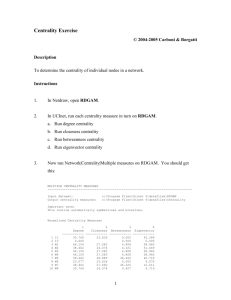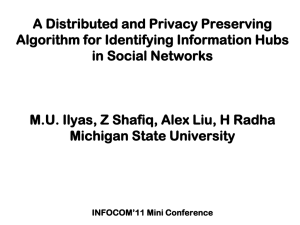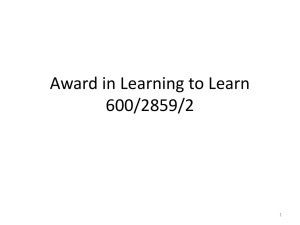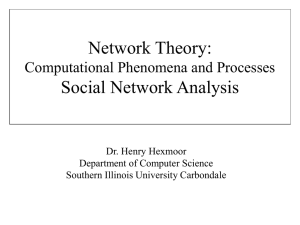Knowledge and Collaboration Networks
advertisement
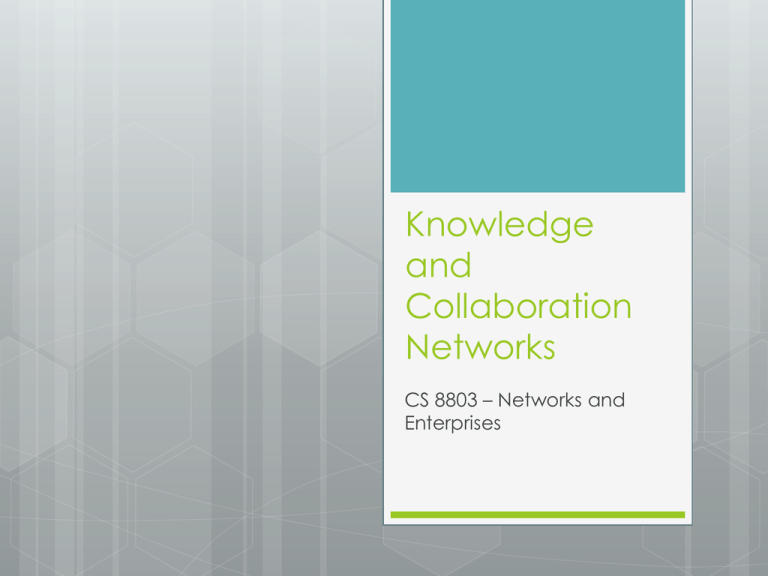
Knowledge and Collaboration Networks CS 8803 – Networks and Enterprises Agenda Basic overview Open Vs. Closed networks Collaborative networks in universities A resource based view on the interactions of university researchers – Rjinsoever, Hessels, Vandeberg Collaborative networks in firms Evolution of R&D Capabilities: The Role of Knowledge Networks Within a Firm - Nerkar, Paruchuri Spillovers firms and collaboration in Biotech Knowledge Networks as Channels and Conduits: The Effects of Spillovers in the Boston Biotechnology Community – Owen –Smith, Powell Comparison of collaborative networks in Universities Vs. Industries Collaborative networks What are collaborative networks ? Is this pertinent to any of us ? What do we gain in understanding the dynamics of these networks? The process Device a model, determine variables Proposition Draw inspiration from existing work Inferences from data Collect the data Conclusions Open Vs. Closed Breaking it down What Who can contribute What is open / closed? is hierarchical / flat? Who decides what to work on and which solution to choose Which one is best? Case studies Alexi furniture firm Linux IBM Innocentive.com iPhone app Takeaways Choose the model based on – Problem domain Availability of experts Combine models when appropriate Change models as problem / firm evolves Collaborative networks in Universities Paper discussion Isn’t this field old, why write a paper about it in 2008? How is this different from old papers? What were the contributions ? What is the main motivating factor? How does it affect scientists ? What was their method of data collection ? Research model Thoughts Was their method of data collection successful ? Did they cover all the possible data sets? How did the variables influence each other ? Some findings were intuitive, did you find any that was not ? What were the limitations of the paper? Takeaways Increase Academic rank by faculty and external networking Matthew effect is present in networks Help younger faculty establish networks and ensure older faculty maintain theirs Hire both adapters and innovators Collaboration in industries Paper discussion What was their method of data collection ? What factors affect the selection of an idea? How did they model the data ? Was this the right approach ? Hypotheses Hypothesis 1 : Centrality of an inventor in an intraorganization knowledge network will be positively associated with the likelihood of his knowledge being selected by other inventors. Hypothesis 2 : The extent of structural holes spanned by an inventor in an intraorganizational knowledge network will be positively associated with the likelihood of their knowledge being selected by other inventors. Hypotheses Hypothesis 3 : The relationship between the centrality of an inventor in an intraorganizational knowledge network and the likelihood of her knowledge being used by other inventors is positively moderated by the extent to which this inventor spans structural holes in the network. Independent, Control variables Centrality Spanning structural holes Calendar Age Patent Age Scope of Patent Claims Age of prior art Self citation Number of patent References Academic references Team size International presence Time to grant Year effects Technological controls Thoughts / Takeaways Centrality and spanning of structural hole has positive effect on propagation of an individual’s idea Inventors shape the capabilities of the firm Socioeconomic view of R&D capabilities of a firm Possible limitations ? Spillovers and collaboration in Biotech firms Spillovers Why map knowledge sharing to plumbing? How do spillovers help a community ? Conduits Vs. Leaks The “wh” questions Why was the biotech industry chosen? Was there prior work which was based on the biotech industry, did they yield concrete results? What was this paper’s distinguishing factor ? Why Boston ? Where did they get the data from ? Propositions Proposition 1: Membership in a geographically colocated network will positively effect innovation, but centrality in the same network will have no effect. Proposition 2: Centrality in a geographically dispersed network will positively effect innovation, but membership per se will have no effect. Proposition 3: In networks dominated by PROs, membership will positively effect innovation, but centrality will have no effect. Proposition 4: In networks dominated by commercial entities, centrality will positively effect innovation, but membership will have no effect per se. Independent/ control variables Membership Position (Centrality) Time periord Public Age Age(square) Log(size) R&D ties - PRO Ties to NIH PRO x NIH ties Takeaways Geographic propinquity and institutional characteristic of key members of network transforms the way in which an organization's position translates into it’s advantage Flow of information depends on density of network and the presence of “leaks” Legal arrangements/ disclosure terms are a consequence of the network’s characteristic (open / closed) Proprietary arrangements dominate once the networks stabilize Comparing the papers Which paper did you like the most ? Which method of data collection was most accurate ? How did the authors select the variables? Did they add new variables ? How are collaborative networks in universities different from those in industries? Which have better innovation? Are these results pertinent to today’s landscape?

